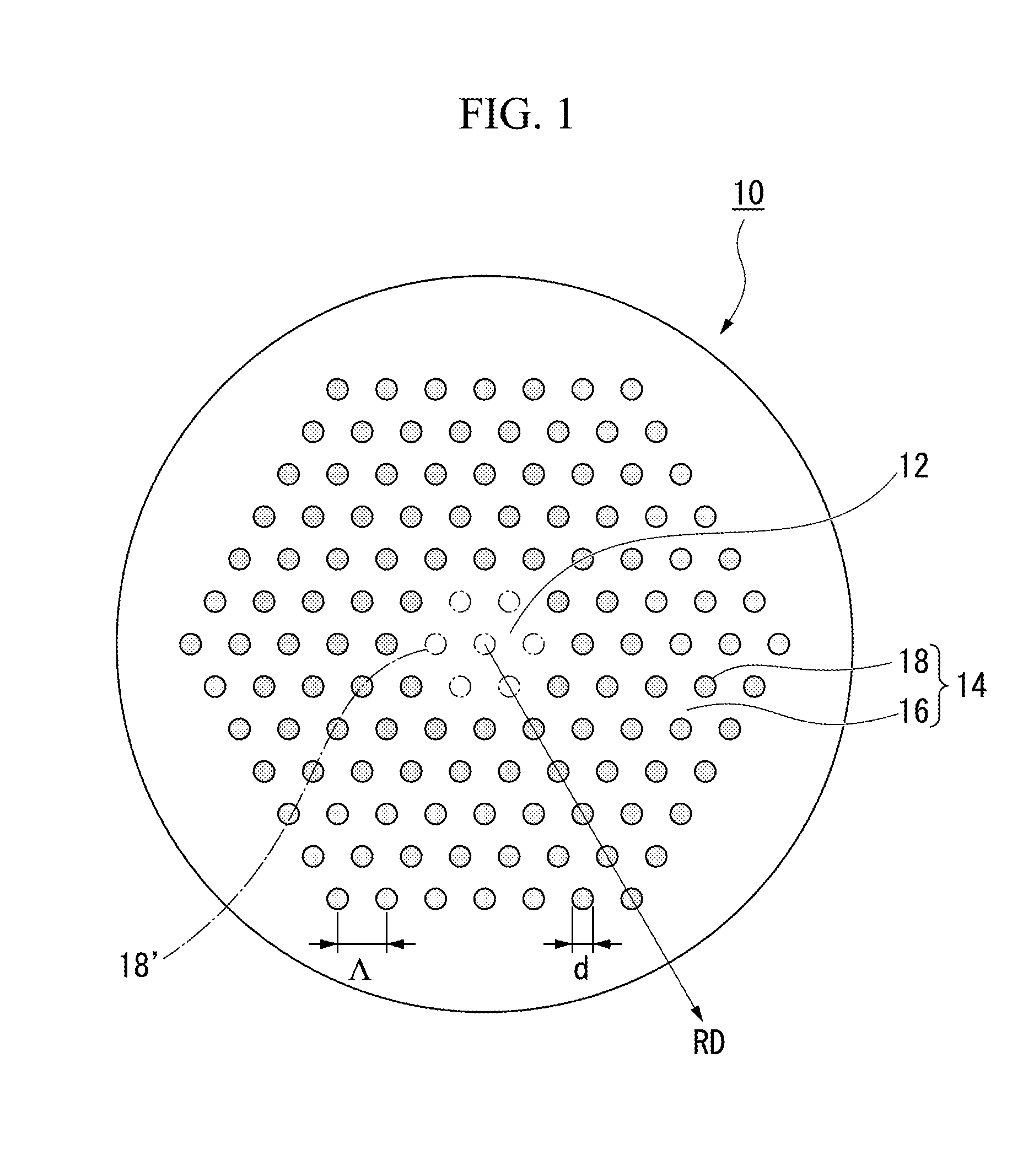Sold photonic band gap fiber, fiber module using sold photonic band gap fiber, fiber amplifier, and fiber laser
a technology of sold photonic band gap, which is applied in the field of optical fiber, can solve the problems of both optical damage and non-linear optical effects, and the effect of reducing the effective core cross-sectional area, and reducing the difference between the bending loss of the fundamental mode (fm)
- Summary
- Abstract
- Description
- Claims
- Application Information
AI Technical Summary
Benefits of technology
Problems solved by technology
Method used
Image
Examples
example 1
[0240]In Example 1, basically, the core area was as large as two layers (seven-cell core structure), and the first band gap was used as the permeation band.
[0241]Specifically, as shown in FIG. 5, Example 1 has a structure which is a two-layer equivalent core type, and has high refractive index scatterers periodically arrayed in a triangular grid shape.
[0242]In manufacturing the fiber, the target Λ was 11 μm, and the target Δ was 2.0%.
[0243]In addition, d was adjusted (approximately 1.8 μm) so that V became approximately 1.6.
[0244]Therefore, when the fiber is used at a wavelength of 1064 nm, the first band gap is used as the permeation band.
[0245]The material of the preform of the optical fiber mainly included silica glass, germanium-added silica glass was used as the material of the high refractive index scatterers, and the preform of the stacking structure was manufactured using the stack and draw method.
[0246]In addition, the preform of the stacking structure was spun while contro...
example 2
[0254]In Example 2, basically, similarly to Example 1, the core area was as large as two layers (seven-cell core structure).
[0255]The third band gap was used as the permeation band.
[0256]Specifically, as shown in FIG. 5, Example 2 has a structure which is a two-layer equivalent core type, and has high refractive index scatterers periodically arrayed in a triangular grid shape.
[0257]In manufacturing the fiber, the target Λ was 13 μm, and the target Δ was 2.5%.
[0258]In addition, d was adjusted (approximately 4.8 μm) so that V became approximately 4.65.
[0259]Therefore, when the fiber is used at a wavelength of 1064 nm, the third band gap is used as the permeation band.
[0260]The material of the preform of the optical fiber mainly included silica glass, germanium-added silica glass was used as the material of the high refractive index scatterers, and the preform of the stacking structure was manufactured using the stack and draw method.
[0261]The preform of the stacking structure was spun...
example 3
[0269]Example 3 is basically an example in which, similarly to Example 1, the core area was as large as two layers (seven-cell core structure), the first band gap was used as the permeation band, and the refractive index distribution of the high refractive index scatterers was not rectangular.
[0270]Specifically, as shown in FIG. 5, Example 3 has a structure which is a two-layer equivalent core type, and has high refractive index scatterers periodically arrayed in a triangular grid shape.
[0271]A fiber having the high refractive index scatterers with a non-step-form refractive index distribution (refer to FIG. 17) in which Λ was 11 μm, and Δ became 2.0% in terms of the step form was manufactured.
[0272]In addition, d was adjusted (approximately 1.8 μm) so that V became approximately 1.6.
[0273]Therefore, when the fiber is used at a wavelength of 1064 nm, the first band gap is used as the permeation band.
[0274]The material of the preform of the optical fiber mainly included silica glass,...
PUM
| Property | Measurement | Unit |
|---|---|---|
| cross-sectional area | aaaaa | aaaaa |
| bending radius | aaaaa | aaaaa |
| cross-sectional area | aaaaa | aaaaa |
Abstract
Description
Claims
Application Information
 Login to View More
Login to View More - R&D
- Intellectual Property
- Life Sciences
- Materials
- Tech Scout
- Unparalleled Data Quality
- Higher Quality Content
- 60% Fewer Hallucinations
Browse by: Latest US Patents, China's latest patents, Technical Efficacy Thesaurus, Application Domain, Technology Topic, Popular Technical Reports.
© 2025 PatSnap. All rights reserved.Legal|Privacy policy|Modern Slavery Act Transparency Statement|Sitemap|About US| Contact US: help@patsnap.com



